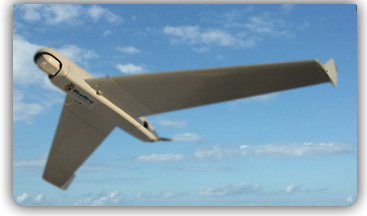Boomerang is an operational UAV with an electric motor weighing 9 kg that can fly for more than nine hours using Horizon's starboard electric propulsion system

The unmanned aerial vehicle (UAV) for prolonged stay in the air, the first commercial powered by a hydrogen fuel cell, called Boomerang, developed by the Israeli company BlueBird Aero Systems and powered by Horizon Fuel Cell Technologies , will be presented as one of the important innovations at the upcoming annual conference of the International Association for Unmanned Systems (AUVSI) in Washington.
Horizon will also present AEROPAK, an independent propulsion system with a 2 kg fuel cell capable of delivering 900 watt-hours, and can increase the flight duration of small and stealthy UAVs by up to 300 percent. Unmanned aerial vehicles are used in a variety of military, homeland security and civilian applications. The unique ability to carry out missions that have long been carried out using a mini UAV, as shown by Boomerang manufactured by Bluebird, is a particularly great advantage in the missions of border patrols, infrastructure supervision, critical assets and environmental monitoring. Boomerang is an operational UAV with an electric motor weighing 9 kg that can fly for more than nine hours using Horizon's starboard electric propulsion system.
Bluebird Aviation Systems completed a three-year effort to integrate PEM (proton exchange membrane) fuel cell technology into a specially designed UAV, and developed support systems such as hybrid capabilities for the system's electrical redundancy, a mechanism for cooling the fuel cell and many others. The UAV powered by a fuel cell is already licensed for flights in Israel and is rated as a mature system.
Well-known Horizon Fuel Cell Technologies from Singapore has advanced the PEM fuel cell technology to new dimensions using advanced lithium batteries in a very light and compact system for storing electrical energy, which is well suited to the needs of small electric drones. In addition to increasing the time spent in the air, Horizon's new fuel cell system makes it possible to increase the capabilities of small aircraft to operate electronic devices, such as electro-optical sensors, infrared cameras and laser designators.

8 תגובות
I have to agree with my predecessor, #7, the hon.
Everything can be done with hydrogen fuel cells, the technology is not drone technology.
There is nothing new here.
Well, if the information appears in Wikipedia then there is probably no problem with it...
S Thanks for the info, you seem knowledgeable on the subject, I just hope you haven't posted classified data here.
UAVs such as those in Israel, for example the Hermes 450, stay in the air for up to 18 hours for an aircraft of slightly less than half a ton, for a plane of slightly more than 1.2 tons, it stays up to 30 hours. With a 5 ton plane stays over 48 hours continuously in the air. All of them are internal combustion engines with the Eitan having a turboprop engine.
In small, electric tools based on lithium ion batteries and designed for collection missions for the frameworks of a battalion up to a brigade, for ranges of 15-50 km, which was a little over 3 hours is the target of the design.
Therefore, a 9 kg craft that is claimed to have flown for about 9 hours is a coup. In general, the data to which such a stay refers are ideal and do not come close to a realistic situation, for example ideal weather without turbulence, without operation of the radar (day/night camera), without operation of the night camera because FLIR consumes more electricity, a minimum of climbs and descents etc. etc.
From extensive personal experience in the field, the reconciliation between the manufacturer's statements and actual performance can take several years.
This is a tool that allows the commander of a relatively small area to control the area without the need for access to the Air Force.
Of course more is always better but 9 hours can be enough depending on the task
For those above me
"The unique ability to carry out long-standing missions using a mini UAV" is quoted from the article.
I'm not sure but I guess the answer to what you're saying is actually that the bigger khetbami are the ones that are capable of such times as you mention. So relatively as a very small UAV it has a long stay capability.
There was talk in the past about unmanned aircraft that would fly for days and weeks non-stop. Passenger planes, for example, are able to fly for 15 hours continuously... 9 hours doesn't sound like much to me, especially when such an aircraft is supposed to reach distant areas that take several hours just to reach them....